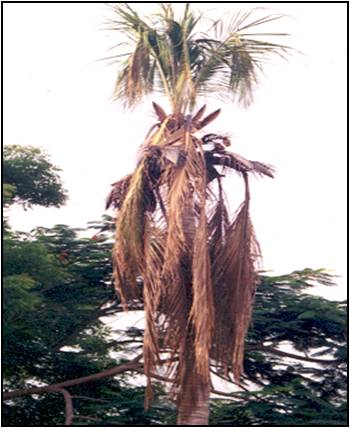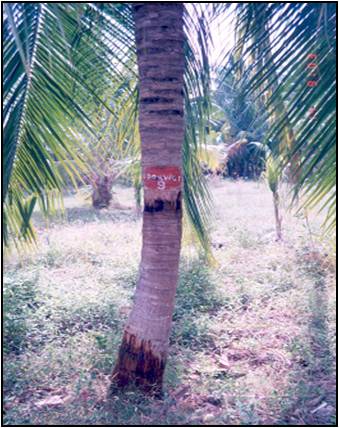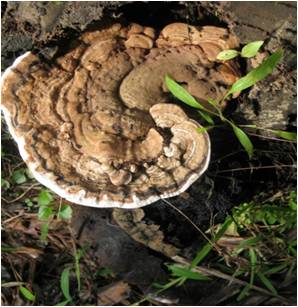GANODERMA
 |  |  |
Blackening of the distal ends of the leaflets | Bleeding patches at basal portion | Fruiting body at basal portion |
Causal organism : Ganoderma applanatum and Ganoderma lucidum
Symptoms
| Yellowing of the leaves of lowest leaf whorl, decay and death of fine roots. | |
| Bleeding patches appear at the base of the stem near the ground level, roots decay extensively and there is no new bunch production. | |
| As the disease advances leaves droop in the outer whorl followed by heavy button shedding and barren nuts. | |
| Formation of fruiting body near the base of palm. |
Disease Management
| Removal of dead palms, palms in advanced stages of the disease and destruction of the bole and root bits of these palms. | |
| Isolation of diseased palms from healthy palms by digging isolation trenches of 1 m deep and 30 cm wide. | |
| Regular basin irrigation during summer months or moisture conservation by coconut husk burial (250 husk/palm). | |
| Avoiding flood irrigation or ploughing in infected gardens to prevent spread of the inoculum. | |
| Addition of 50 kg of farmyard manure or green leaves or 200 kg tank silt per palm per year. | |
| Soil application of 5 kg neem cake fortified with 50g of Trichoderma talc formulation per palm per year | |
| Raising banana as intercrop wherever irrigation is possible. | |
| Soil drenching with 40 L of 1 per cent Bordeaux mixture thrice a year for one year. | |
| Root feeding of 2 g of Aureofungin solution+ 1 g of Copper sulphate in 100 ml of water thrice a year at quarterly interval. Alternatively root feeding of 1% hexaconazole5EC (contaf ) at quarterly intervals for one year and soil drenching with 40 liter of 0.2% hexaconazole. |
